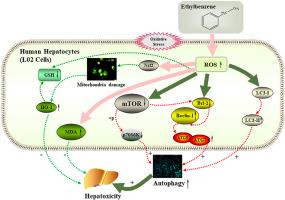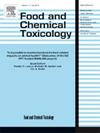mTOR-p70S6K信号通路和HO-1在乙苯诱导的L02细胞肝毒性效应中的作用
IF 3.9
3区 医学
Q2 FOOD SCIENCE & TECHNOLOGY
引用次数: 0
摘要
在我们之前的研究中,乙苯(EB)诱导的肝毒性效应被认为是体内氧化损伤和线粒体介导的细胞凋亡,但其机制仍不清楚。本研究旨在探讨 mTOR-p70S6K 信号通路在 EB 诱导的体外肝毒性效应中的作用。将正常人肝细胞(L02 细胞)暴露于不同浓度的乙苯(0-10 mM)中 24 小时。在体外,我们发现乙苯处理通过诱导氧化应激、线粒体损伤、过度凋亡和自噬,降低了 L02 细胞的活力。与此同时,mTOR-p70S6K 信号级联失活,表现为相关分子 Atg 家族蛋白和血红素加氧酶-1(HO-1)水平下降。mTOR 抑制剂处理和免疫荧光分析进一步证实了这些发现。综上所述,我们的研究结果表明,EB通过抑制mTOR-p70S6K信号传导,引发L02细胞线粒体损伤、过度凋亡和自噬,从而诱导肝毒性效应;氧化应激影响HO-1的被动上调。本文章由计算机程序翻译,如有差异,请以英文原文为准。

Roles of mTOR-p70S6K signaling pathway and HO-1 in ethylbenzene-induced hepatoxic effects in L02 cells
Ethylbenzene (EB)-induced hepatotoxic effects has been indicated as oxidative damage and mitochondria-mediated apoptosis in vivo in our previous study, yet the mechanisms remain unclear. This study aimed to explore the role of the mTOR-p70S6K signaling pathway in EB-induced hepatoxic effects in vitro. Normal human hepatocytes (L02 cells) were exposed to different concentrations of ethylbenzene (0–10 mM) for 24 h. In vitro, we found that EB treatment decreased the viability of L02 cells, via inducing oxidative stress, mitochondrial impairments, excessive apoptosis and autophagy. These were accompanied by the inactivation of the mTOR-p70S6K signaling cascade, as manifested by the decreased levels of related molecules Atg family proteins and Heme oxygenase-1 (HO-1). These findings were further confirmed by mTOR inhibitor treatment and immunofluorescence analysis. Jointly, our results indicate that EB induces hepatoxic effects by triggering mitochondrial impairments and excess apoptosis and autophagy in L02 cells via suppressing the mTOR-p70S6K signaling, and oxidative stress affects the passive up-regulation of HO-1.
求助全文
通过发布文献求助,成功后即可免费获取论文全文。
去求助
来源期刊

Food and Chemical Toxicology
工程技术-毒理学
CiteScore
10.90
自引率
4.70%
发文量
651
审稿时长
31 days
期刊介绍:
Food and Chemical Toxicology (FCT), an internationally renowned journal, that publishes original research articles and reviews on toxic effects, in animals and humans, of natural or synthetic chemicals occurring in the human environment with particular emphasis on food, drugs, and chemicals, including agricultural and industrial safety, and consumer product safety. Areas such as safety evaluation of novel foods and ingredients, biotechnologically-derived products, and nanomaterials are included in the scope of the journal. FCT also encourages submission of papers on inter-relationships between nutrition and toxicology and on in vitro techniques, particularly those fostering the 3 Rs.
The principal aim of the journal is to publish high impact, scholarly work and to serve as a multidisciplinary forum for research in toxicology. Papers submitted will be judged on the basis of scientific originality and contribution to the field, quality and subject matter. Studies should address at least one of the following:
-Adverse physiological/biochemical, or pathological changes induced by specific defined substances
-New techniques for assessing potential toxicity, including molecular biology
-Mechanisms underlying toxic phenomena
-Toxicological examinations of specific chemicals or consumer products, both those showing adverse effects and those demonstrating safety, that meet current standards of scientific acceptability.
Authors must clearly and briefly identify what novel toxic effect (s) or toxic mechanism (s) of the chemical are being reported and what their significance is in the abstract. Furthermore, sufficient doses should be included in order to provide information on NOAEL/LOAEL values.
 求助内容:
求助内容: 应助结果提醒方式:
应助结果提醒方式:


